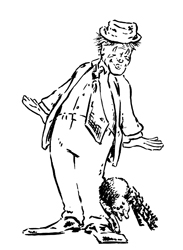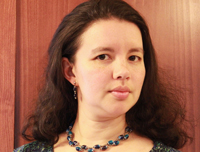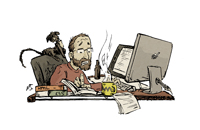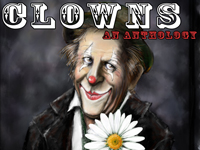Everyone’s a Clown
By Caroline M. Yoachim
Clown by Bryan Prindiville
When Amelia turned six, I took her to the circus. She’d been a little withdrawn lately, and I wanted to cheer her up. She watched with a grim expression as elephants marched around the ring. “What’s the matter?”
“The elephants look unhappy.”
I couldn’t see anything wrong with the elephants, and the spotlight shifted to a trio of clowns. “Look at the clowns, Meelie, see the big red smiles?”
“You can see their faces? Do you like them?”
“Sure,” I said, baffled by her odd response. I stared at the clowns. Amelia mumbled something and touched my arm to get my attention. Her face was painted like a clown — a bright red mouth and paper-white skin, black triangles above and below her eyes.
The woman in the next seat had clown make-up too, and a bright red wig. I scanned the audience. Every single seat was occupied by a clown. Sad clowns, happy clowns, scary clowns, nothing but clowns as far as
I could see in the dim light. It had to be a trick, part of the act.
The show continued, and every performer was a clown. Amelia spent more time looking at me than at the stage. I tried to pretend that nothing was wrong so she wouldn’t worry.
![]()
“Not long after the circus, my daughter turned into a sad clown, with a blue teardrop beneath her left eye,” I told the neurologist. Dr. Williams was a silly clown, with a big red nose and high-arched eyebrows. Her rainbow hair framed her face in tight ringlets. I wondered what she looked like to other people.
“I’m amazed you can recognize people,” she said.
“Everyone’s a clown, but they aren’t all the same clown.”
She studied my MRI results. “There’s nothing physically wrong with your fusiform gyrus, or anywhere else on the scan.”
“What else can we try?” I asked. I needed to stop seeing clowns. I worried that my break with reality was what made my daughter so sad. We never should have gone to the circus.
“Maybe a psychiatrist?” Dr. Williams suggested. She gave me a referral.
![]()
“Midnight was sick all over the carpet,” Amelia reported when I got back from my appointment. She had two tears under her left eye. That was a bad sign. People’s clown faces didn’t change for passing moods.
“I’ll clean it up.” Midnight’s favorite cat pastimes were eating grass and puking on the carpet. I sprinkled a box of baking soda over the befouled area. “Is everything okay at school?”
Amelia nodded.
“Are you worried about something?” I asked. Amelia struggled with putting her feelings into words, as kids often do. Hell, grownups too. But I had to figure out why her clown face was so sad.
“Do you know what your face looks like?” she asked.
My heart sank. It was me, then. I’d been avoiding mirrors, but I didn’t want Amelia to worry. In the most cheerful voice I could muster, I said, “Let’s go look together at the mirror.”
That was a mistake.
My too-big mouth was filled with pointy teeth and my eyes were bloodshot red with black pupils. I searched the face in the mirror for any feature that I recognized, any sign of what I’d looked like before my brain started distorting faces, but all I saw was a terrifying clown. I remembered that Amelia was standing beside me. Thank God she couldn’t see what I saw.
“What’s the matter with my face?” I asked.
“You used to be such a happy clown, and now you look scary. You look like worry and fear.”
![]()
I didn’t bother with the psychiatrist. If Amelia was seeing clowns, it had to be genetic. Or contagious, but I didn’t even want to think about that. We sat down and talked, and she told me that her teacher was a sad clown, and the other kids were happy or silly or sad or scared. I asked her when she started seeing clowns, and she said she’d always seen them, she just hadn’t known they were clowns until we went to the circus.
“I see clowns too,” I told her, “and I’m worried because your clown looks sad.”
“I don’t like seeing everybody’s inside feelings,” Amelia said. “Have you looked at the cat?”
“Midnight?” The cat seemed fine, perched on top of the bookshelf. “She looks okay to me. What do you see?”
“I don’t want to share it with you,” Amelia said. “I think you don’t like seeing the clowns.”
“You didn’t make me see clowns,” I reassured her, “It was something about the circus—”
“No,” Amelia said. “It was me. I thought you wanted to see what I saw.”
I didn’t really believe her, but I didn’t want her to feel bad. “Okay, no problem. I see what you see, but not the cat. Let’s share that too.”
She touched my cheek, and one of her clownface tears faded away. Seeing clowns wasn’t so bad. I could deal with a clown-cat if it would make my little girl happier.
I looked up at Midnight.
Perched on the bookshelf was a cat-sized spider, with beady black eyes and hairy legs. I flinched, but managed not to scream. “Has she always looked like that? I mean, to you?”
Amelia shook her head. “I think she’s sick.”
“We’ll take her to the vet.”
![]()
The vet was a tired-looking clown with faded blue hair. The waiting room was full of hideous creatures — dog-sized maggots and featherless birds and a guinea pig that didn’t have a face. Amelia was completely unfazed, and sat with our giant spider-cat on her lap.
 This was my new world, her world, full of horrifying animals and clown faces.
This was my new world, her world, full of horrifying animals and clown faces.
A happy clown came out of the treatment room with an ordinary-looking dog. I hoped the vet could cure our cat. I hated spiders. I almost wished I hadn’t volunteered to see what Amelia saw. Then I saw her contented little clown face. If sharing these nightmarish visions was what it took to make her happy, I wouldn’t flinch away.
I stroked one of Midnight’s furry legs and tried to pretend the hissing noise was a purr.
![]()
 Unlikely Story
Unlikely Story



